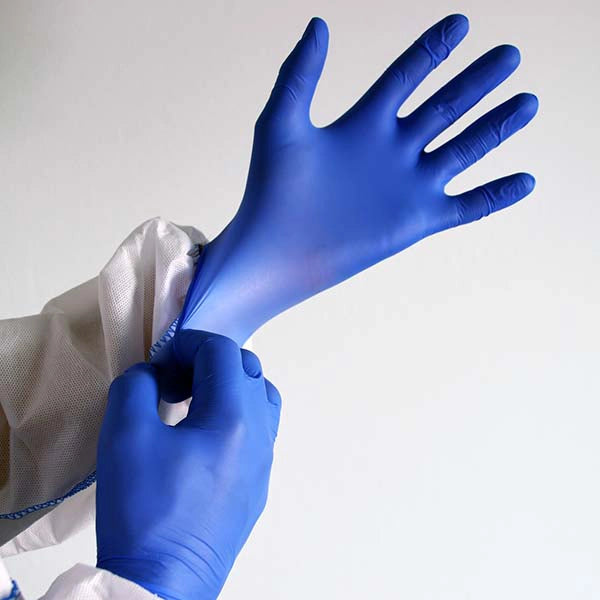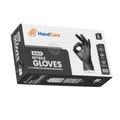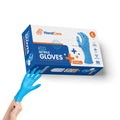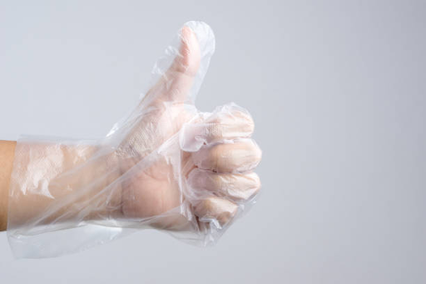While the world of disposable gloves is expansive, not all gloves are created equally. With any glove, thickness has a surprising impact on the kinds of jobs it can handle. The thickness of gloves comes down to the thickness of their materials, which determines the amount of protection they can give — be it nitrile, vinyl, or latex.
Disposable gloves come in a range of thicknesses, so what kind should you choose? In a quick glance, with thin gloves, you lose greater protection but gain a lighter glove that provides more tactile sensitivity. With thicker material, you get an extremely durable glove and safer handling of hazardous materials.
Today’s blog post takes a look at thickness is best for disposable gloves, be it nitrile gloves or latex gloves.
Why the Thickness of the Gloves Matter
Wearing the wrong gloves can affect the job you are doing, so choosing the best disposable gloves for the job is a big decision. Industrial and exam grade gloves have different needs, materials, thickness, and permeability. When purchasing disposable nitrile gloves for your use, it’s important to determine what your task is, what kind of gloves you need, and be guided by those requirements.
The appropriate gloves for your task make all the difference when completing a task. Whether you choose a nitrile glove or latex gloves, you must consider your requirement first. Hence, a 3-mil glove may be lighter than the four mils or five mils, but in practice, they feel just as sturdy—just be sure they are the correct thickness for your use. The same could go for the four mils versus the five mils—you don’t want a glove that is too heavy for your specific process.
For example, thin latex gloves, such as those worn by surgeons, allow for greater dexterity, flexibility, and sense of touch. However, they are not durable enough to withstand the heavy use required in certain occupations, such as manufacturing which calls for thicker nitrile gloves.
Thin or Thick Disposable Gloves: Which to Use?
Disposable gloves have many use cases, but these factors should help you decide what thickness works best for you. For a nitrile glove that pairs a balance between comfort and protection, people may want to opt for a midweight option. If a strong, puncture-resistant glove is the top priority, then a heavy-duty version might be necessary. But if you are looking for an economical option that will perform very specific tasks without sacrificing tactile sensitivity, thin latex or nitrile gloves may be right for you.
The important takeaway is that there are multiple options to consider; don’t let the rumor of disposable nitrile gloves being inherently thick, deter you from using these versatile gloves for everything from working in your garden to keeping safe as you clean up after an oil spill. Thick and thin gloves each have their own pros and cons, but at the end of the day, it is a matter of appropriateness to the task you are about to take.
What is mil in Gloves?
Mil in gloves is a measurement that indicates the thickness of the glove material, expressed in thousandths of an inch. This measurement is crucial for determining the glove’s durability, flexibility, and overall protective capabilities. For example, a glove with a 4 mil thickness is thinner, offering greater dexterity and tactile sensitivity, which is essential for tasks requiring precision, such as medical procedures or detailed assembly work.
On the other hand, a glove with an 8 mil thickness is much thicker and provides robust protection against punctures, abrasions, and chemical exposure, making it ideal for heavy-duty industrial environments. Understanding mil thickness allows users to choose the right glove for their specific needs, balancing protection with comfort and functionality.
When selecting gloves, it’s important to consider the specific requirements of the task at hand. Gloves with a lower mil thickness may be sufficient for light-duty tasks where sensitivity and flexibility are key, but they may not offer the necessary protection in more hazardous conditions.
Mils vs Microns
In America, glove thickness is usually expressed in mils, or thousandths of an inch. Contrary to popular belief, a mil is not the same as a millimeter—it's a unit of thickness equal to one-thousandth (.001) of an inch.
However, other countries use Micro Meters (Microns), a unit of length equal to one-millionth of a metre. So if you are in another country shopping for disposable gloves, the number of microns indicated is its level of thickness.
The Best Thickness for Disposable Gloves
Disposable gloves generally range from 4-15 mils thick. While the current glove standard is 3 mil thick and premium ones are 5 mil or more, but they will need to be measured at the wrist, fingertips, and palm. Low-numbered gloves provide greater dexterity, flexibility and sense of touch than high-numbered gloves. High-numbered gloves provide greater durability, but lower flexibility than low-numbered gloves.
-
Under 2-mil thick gloves:
These gloves are most often used for light-duty tasks. They are also economical and are suited to any food-prep tasks where you constantly need to change gloves.
-
3-mil or less thick gloves:
Gloves with a thickness of 3 mils or less are suited for jobs that do not require strong protection from chemicals or hazardous materials. Such gloves are preferred for applications requiring frequent glove changes in food service, janitorial, and salon & beauty applications.
-
4 to 6-mil thick gloves:
Thicker gloves, those measuring 4 mil to 6 mil, are created with more material and stronger materials and so can withstand greater tension. These are usually a nitrile glove and are a good choice for general duty and for heavier duty uses involving tools and machinery.
-
8-mil and above thick gloves:
Those gloves rated 8 mils and above are suited for heavy-duty work and specialized tasks, given that the higher is the mil thickness, the more rigid the glove.
The Best Range for Disposable Nitrile Gloves
Meanwhile, disposable nitrile gloves usually range in thickness from 4 mils to 8 mils, with the majority of heavy-duty industrial and laboratory grade nitrile gloves ranging from 6 to 8 mils thick. The thicker the nitrile glove, the higher level of protection.
Heavy-duty nitrile gloves provide a longer permeation time when working with chemicals and more tear resistance than thinner light-duty or medical grade gloves.
Glove Thickness Varies
However, keep in mind that the thickness of a nitrile glove or a latex one varies from one part of the hand to another. This means glove thickness is not uniform across the whole glove. Glove manufacturers rate glove thickness based on the amount of material at the fingers and palm, while also considering the rigidity of the material throughout the rest of the glove.
Gloves are usually made by dipping hand-formers into liquid material with the fingers pointing downward. As they begin drying, the law of gravity applies as solution is pulled downward: Fingertips are thicker than wrists, with palms somewhere in the middle.
How To Read Glove Thickness
When you see a nitrile glove labeled 4 mil, that measurement is usually based on the thickness in the fingertips, which makes sense since your fingers are most likely to do the handling and thus are most susceptible to puncturing and tearing when wearing the disposable glove. This applies for all disposable gloves including nitrile gloves and latex.
Gloves become more costly as they become thicker, as this process requires more material and manpower. Meanwhile, resistance from chemical hazards varies with thickness. The thicker the glove, the stronger the resistance against chemical hazards, but dexterity is reduced.
Size and Thickness
If you find that a nitrile glove has ripped, the first thing to ask is whether you are wearing the correct size. Most gloves have an Acceptable Quality Limit, or AQL rating, which indicates an acceptable percentage of ripped gloves in any one batch.
Many users rip disposable glove not because the nitrile glove is too thin, but because they are trying to force his or her hand into a glove that is too small.
Glove Thickness and Allergy
You probably wonder if a thick glove can cause allergy. The answer is no. Allergic reactions are usually caused by the material and hence, glove manufacturers offer latex free gloves as well as powder free gloves in both nitrile and vinyl options.
Cornstarch powder-coated gloves are easier to put on and prevent gloves from sticking together. However, they may cling to the wearer's skin and cause sensitivities or allergies.
Powder-free nitrile gloves undergo a process known as chlorination in which they are treated with a chlorine solution, rinsed with water, and dried to remove most of the powdered residue and latex proteins. Powder-free nitrile gloves can be harder to remove quickly and may decrease the firm grip, but they are more sanitary. They also tend to be more expensive than powdered gloves because of extra steps involved in the chlorination process.
Conclusion
We hope that these insights into the benefits of each glove thickness will help you make an informed decision about your particular needs and tasks.
If you’re looking for a consistent, strong glove to stand up to punctures and tears during regular work with chemical or sharp objects, or just some extra durability, then the thick nitrile gloves or latex glove is worth considering. If you need a more flexible and cost-effective glove, then the thin choice may be a better choice.
Either way, disposable nitrile gloves are usually great options in their own right, so go ahead and make the choice that’s right for you.
At the end of the day, it is important to choose the best gloves that are right for the job. We should not rely on size or thickness as the only way to guide these choices. A combination of the fabric type, thickness, and application will ensure success in any situation when using a nitrile or latex glove.
Where To Buy The Best Gloves For Your Needs?
When it comes to purchasing gloves that meet your specific needs, gloves.com stands out as the best option. With a wide range of gloves available in varying thicknesses and materials, they cater to every requirement, whether you need lightweight gloves for tasks requiring precision or heavy-duty gloves for more demanding applications. gloves.com offers high-quality products that ensure durability, protection, and comfort, making them the go-to source for disposable gloves.
By choosing gloves.com, you can trust that you’re getting the best in the industry, backed by a company that understands the importance of selecting the right glove for every job.








